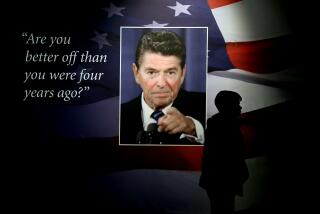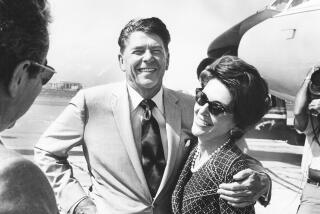Heal the Lame Ducks?
- Share via
The trend of thought regarding presidential terms seems to have moved full circle with President Reagan’s suggestion that the two-term limit be removed. The proposal deserves serious consideration.
The current limit, proposed in 1947 and ratified in 1951, was in reaction to Franklin D. Roosevelt’s election to third and fourth terms and the relative increase in presidential powers in modern times. Only one President, Dwight D. Eisenhower, has served two full terms since then, and thereby might have been in a position to have run for a third if allowed.
In recent years presidential reform focused on the idea of a single six-year term. One of the major proponents was the late Dr. Milton Eisenhower, President Eisenhower’s brother. Advocates argued that a single term would provide for a more effective presidency, since the Chief Executive would not have to concern himself with the politics of the next election. The one-term concept failed to gain widespread or substantial support, however. The more prevalent view was that it would provide a six-year lame-duck presidency. There also was concern that, short of impeachment, the nation might have to suffer additional years under an ineffective and unpopular Chief Executive without recourse to the remedy afforded by elections.
While Reagan’s record does not indicate outspoken support for a two-term limit in the past, the President repeatedly indicated while governor of California that he felt that two terms were entirely appropriate for that office.
Reagan’s unexpected advocacy for removal of the two-term limit surfaced at a private meeting in Tampa, Fla., recently with members of the American Legislative Exchange Council, a group of conservative lawmakers.
Asked if he was concerned about being a lame-duck President, Reagan assured the group that he planned to be a very active executive during the final three years and three months of his second term. But he added that “the people ought to have a right to decide who their leadership would be.” The statement was made with the understanding that a change in the limit could not be made in a way that would allow Reagan to seek a third term himself.
It is not unlikely, however, that the President has reflected on his inability to move Congress following his second landslide election in the way that he did after the first. Some loss of effectiveness undoubtedly has been caused by the wholesale change in the White House staff just as Congress was opening its 1985 session. And there is still the possibility that the President can regain the initiative to some extent.
But a weakening of his influence has been strikingly apparent on a number of issues--including the budget, sanctions on South Africa and trade policy. While Republicans still control the Senate, a number of GOP senators facing election next year have become increasingly independent from the White House and presidential policies that may be handicaps in their home states. Those senators might be more deferential to the President were there a chance that he could remain in the White House throughout their coming terms.
The history of the presidency clearly shows that a Chief Executive is likely to seek a third term only in extraordinary circumstances. History also indicates that abuse of the President’s constitutional powers can occur in a first or second term as well as a third. And the nation now has a constitutional provision in the 25th Amendment to provide for the succession of the vice president should the Chief Executive become incapacitated and unable to fulfill the duties of office.
The major remaining argument in favor of a limit, therefore, seems to be one party’s jealousy over the extraordinary popularity and effectiveness of a President from the other party. Reagan would do the country a service by projecting his suggestion into a vigorous public national debate.
More to Read
Get the L.A. Times Politics newsletter
Deeply reported insights into legislation, politics and policy from Sacramento, Washington and beyond. In your inbox three times per week.
You may occasionally receive promotional content from the Los Angeles Times.










